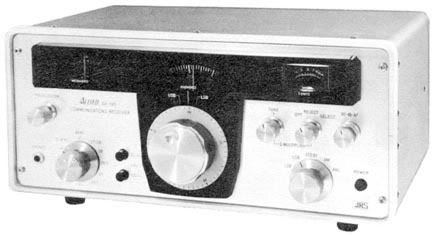For the past few days I've been listening to an early-1970s era receiver, an Allied AX-190. The AX-190 is a ham bands-only solid-state receiver that sold new in the $250 price range. At the time, it was considered a mid-range receiver, a step above some of the other cheaper ham receivers, but not on par with what Drake and Collins were offering.
For a 35-year-old receiver, its simply fun to use. I mostly use it on 75/80 and 40 meters, and its plenty sensitive on those bands. Above 14 MHz the sensitivity falls off, but that's not an uncommon trait among receivers of that era. The ham magazines of the day noted this, and there are a number of mods you can perform to improve its sensitivity on those higher frequencies.
The AX-190 has a nearly identical sister rig, the SX-190. The SX model was aimed at the SWL community, and it was identical in appearance to the AX version.
The AX version covered 80-10 meter ham bands plus WWV at 15 MHz and the 11 meter CB band. The SX version added to this selection the 49, 31, 25, 19 and 16 meter SW broadcast bands.

Performance-wise, the rig is no disappointment. With .5 microvolt sensitivity, its on par with most of my newer receivers (at least on 75 and 80 meters). It lacks crystal filtering optioins, which is its main downfall. A Q-Multiplier aids selectivity, but is no replacement for a good tight crystal filter on a crowded band. As noted in a CQ magazine review of the rig, the peak of the Q-Multiplier is rather broad, which makes it a better tool for use in battling QRM on SSB.
The receive bandwidth spec is 4 kHz, which is a bit narrow for optimum sound quality on AM, and a bit broad for good selectivity on SSB and CW.
Compared to any of my other classic ham rigs — solid state and tube gear — the Allied equals them all on the lower HF bands, with less drift than any of them.
I remember seeing the AX/SX-190 advertised for sale in the SWL magazines and magazines that carried SWL columns. The receiver's styling is unique and I think its a clean, timeless design. It's very similar to the Kenwood 599 “twins” that were produced about the same time. In fact, many believed the AX/SX rig was a Kenwood product under the Allied nameplate.
While probably inspired by the Kenwood styling, the AX/SX-190 was a product of General Research Electronics (GRE) of Tokyo and imported by Allied/Radio Shack from 1971-73. GRE also made the DX-150/DX-160 desktop receivers that Radio Shack sold for many years.
BUG-A-BLOOEY. As mentioned in my last entry, I did go ahead and work on my latest Vibroplex key, the 1942 Blue Racer DeLuxe. The contacts on old keys that haven't been in service are nearly always severely tarnished; I guess decades of sitting around unused allows the silver contacts to tarnish to the nth degree.
Tarn-X is the only thing I use for cleaning key contacts. You have to be very careful with it, and I use a cotton swab when I use the stuff. I try to keep it off chrome, brass, and other metal (as well as my fingers). Reading the MSDS sheet, the stuff really isn't that much of hazard to health, but its pretty vile smelling. It does a great job on tarnished silver, and its much better than using anything abrasive to clean key contacts.
After cleaning the Blue Racer's contacts and getting everything adjusted, it turned out to be a very, very fast key. Most Blue Racers I've tried tend to make very rapid dits. My homebrew “bug tamer” easily allowed for more readable dits — or at least a dit rate more in line with my sending/receiving ability.
Band conditions were pretty terrible early Monday evening for the Kentucky Emergency Net. I couldn't hear the SEC calling the net in Lexington, so I started the KEN on the same frequency. Both of us had check-ins who couldn't hear the other net on the same frequency — that's how bad it was!
By 10 p.m., 75/80 still seemed very long. Copy was very rough for the KSN, the NCS was dropping totally into the noise at some times, and his signal never rose above an S3. I was ready to check in with my Blue Racer. After the NCS recognized me, I was checking in and the bug tamer jumped out of place, locking the keying lever against the dit contact and throwing a carrier (or a very long dah). I fumbled with the bug tamer and tried again, and it popped off a couple of characters later. I had my old faithful bug, my Lightning Bug, on the desk and quickly completed my transmission with that key. God Bless the NCS, he had to cope with my fumbling as well as crapola band conditions.
I think there was only one other check-in, whom I couldn't copy. The NCS closed up shop early due to the conditions. I could hear stations 1000 miles away like they were next door. Go figure.
That's it for this installment. Let's hope conditions improve!
